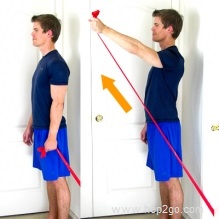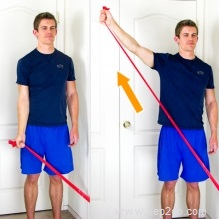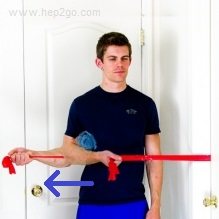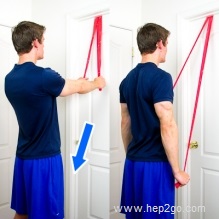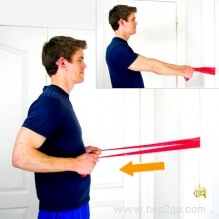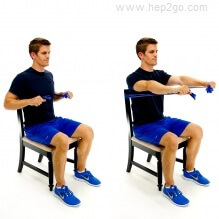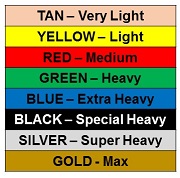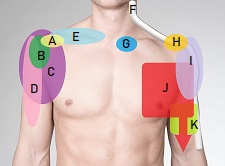- Home
- Shoulder Exercises
- Resistance Band Exs
Shoulder Rehab Exercises
Written By: Chloe Wilson BSc (Hons) Physiotherapy
Reviewed By: SPE Medical Review Board
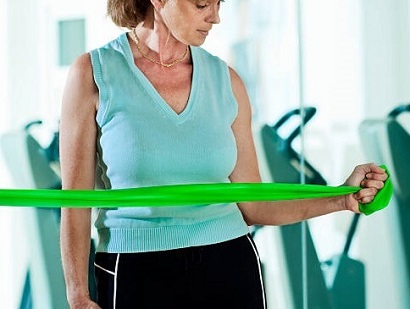
Shoulder rehab exercises help to improve the strength and function of the arm.
The shoulder needs good strength and mobility so that the arm can move freely without any discomfort.
Whether you are recovering from a shoulder injury, such as a rotator cuff tear, shoulder surgery, are an athlete looking to improve both strength and performance, or find your shoulder clicking or popping, these exercises can be tailored to help you. Strength training without the need for weights!
Why Use Theraband?
Theraband is a great tool when doing shoulder rehab exercises. It is a specially designed elastic band that provides graded resistance to movements helping to improve both the strength, mobility and stability of the shoulder.
Theraband exercise bands are versatile, cost-effective and come in eight different colors, each with a precisely calibrated strength providing a different level of resistance. Lighter resistance bands are suitable after an injury/surgery whereas higher resistance bands provided heavy duty resistance for maximum resistance training.
By choosing the right resistance level i.e. the correct colored band, these theraband shoulder rehab exercises can work for someone recovering from an injury or an elite level athlete - the overall goal is the same, – improve strength, mobility and performance.
Advantages
Here are just some of the advantages of using theraband resistance bands with shoulder rehab exercises:
- Cost-Effective: Prices start at around $10/£5
- Adaptable To Any Level: Suitable whether you are a beginner or an expert, whatever intensity shoulder rehab exercises you want to work at
- Works With Any Exercise: You can use them with simple exercises such as biceps curls (bending and straightening the elbow) or with full body workouts. You can even use more than one band at the same time to target different muscle groups
- Small, Light & Portable: They don’t take up much space, don’t hurt if you drop them on your toe, and can be easily packed in a suitcase taking up virtually no weight or space – much easier to carry around than weights!
- Versatile & Allow Variety: Make exercises more interesting by adding in the bands - the same exercise will feel very different. You can use them in loads of different ways so you’ll never get bored!
- Measure Progress: As you progress through the different color bands you can easily see how far you have come with your shoulder rehab exercises
- Extremely Effective: Simple, but extremely effective at building up your muscle and bone strength, stamina and range of motion
If you're looking for somewhere to start before getting hold of some theraband, check out these rotator cuff exercises.
Shoulder Rehab Exercises With Theraband
These theraband shoulder rehab exercises are a great place for almost anyone to start, however if you've had an injury/surgery make sure you can comfortably do these beginners exercises first.
With each of these theraband shoulder rehab exercises it is important that you start in a good position to get the best results.
Make sure you are sitting/standing upright, not slouched forwards. To set your shoulders in the right position, draw your shoulders up 2cm, then back 2cm and then down 2cm. This will engage the stabilising muscles around your shoulder blade to help open up the shoulder joint and allow free, controlled movement. You can find out more in the scapula stabilization exercises section.
1. Shoulder Flexion
This rehab exercise targets the muscles that bring the arm forwards and above your head and is particularly important for lifting and reaching activities.
- Fix one end of the band to something secure and low down e.g. a table leg. Hold the other end of the band in your hand, like you would hold a microphone, with your arm down by your side
- Slowly bring your arms forwards as high as feel comfortable, keeping your shoulder blade drawn back slightly (as described above)
- Hold for 3 seconds and then slowly lower the arm back down – you may well find it harder to control the movement on the way back down
- Repeat 10-25 times, 1-2x daily
Top Tip: To make it easier, start with your elbow bent, and keep it bent throughout the exercises – this shortens the lever so the muscles don’t have to work as hard.
2. Shoulder Abduction
This shoulder abduction rehab exercise targets the muscles that bring the arm out to the side and above your head, again important for reaching, lifting and overhead activities.
- Fix one end of the band to something secure and low down e.g. a table leg
- Hold the other end of the band in your hand, like you would hold a microphone, with your palm facing forwards and your arm down by your side
- Slowly take your arm out to the side, leading with your thumb, as high as feels comfortable, keeping your shoulder blade drawn back
- Hold for 3 seconds and slowly lower
Top Tip: To make it easier, as you lift the arm, let the elbow bend to shorten the lever
3. External Rotation
This exercise targets the muscles that twist the arm out to the side e.g. putting your hand behind your head
- Fix one end of the band to something secure at waist height e.g. door handle
- Hold the other end of the band in your hand, like you would hold a microphone, with your palm facing upwards, your elbow bent and your forearm resting across your stomach
- Slowly twist your forearm out to the side, pulling the band as far as comfortable. Make sure you keep your wrist stable, don’t let is flex or twist
- Hold for 3 seconds and slowly bring your hand back in
Top Tips: 1. It can help to place a small rolled up towel between your elbow and waist, that you gently squeeze as you do the exercise – this helps you to keep your arm in by your side, targeting external rotation rather than abduction
2. Keep the wrist locked solid throughout, don’t let it twist or flex out to the side
4. Internal Rotation
Internal rotation exercises target the muscles that twist the arm inwards e.g. putting your hand behind your lower back, scratching your back or fastening your bra.
- Fix one end of the band to something secure at waist height e.g. door handle. Place a rolled up towel between your elbow and waist
- With your elbow bent and your palm facing up, let your hand/forearm move out to the side as far as is comfortable and take hold of the end of the theraband
- Slowly bring your hand/forearm in across your body as far as comfortable. Make sure you keep your wrist stable, don’t let is flex or twist
- Hold for 3 seconds and slowly bring your hand back out
Top Tips: 1. Keep your elbow by your side – don’t let the towel drop
2. Keep the wrist locked solid throughout, don’t let it twist or glide to the side
3. To make it easier, start with the forearm/hand in line with your body rather than out to the side.
5. Shoulder Extension
This shoulder rehab exercise targets the muscles that move the arm backwards e.g. pulling movements. You can either work on one arm at time or both arms together
- Fix the band to something secure around head height e.g. in a door frame – either tie a knot in the theraband or tie it to something so that it can’t slide back through the door frame when you pull. If you are wanting to work both arms, fix it in the middle of the theraband, if working one arm, fix it at the end
- Stand facing the door and lift one or both arms forwards as high as is comfortable and take hold of the end(s) of the band, like you are holding a microphone, thumb pointing to the ceiling
- Slowly draw your arm down, leading with your little finger aiming to take your arm back behind you
- Hold for 3 seconds and slowly let the arm come back to the starting position
Top Tips: 1. As you draw the arm down, think about gently drawing the shoulder blades back and down too, as if you are trying to squeeze them together
2. To make it easier, start with and keep the elbows bent at a right angle as you perform the exercise - this shortens the lever so the muscles don't have to work as hard
6. Rowing
Rowing shoulder rehab exercises are great for the posterior deltoid muscle at the back of your shoulder and the shoulder blade muscles which help with stability. You can also target the triceps too (see progression). It is usually best to work both arms at the same time with this one.
- Fix the middle of the band to something secure at waist height e.g. door handle
- Face the door, raise your arms straight out in front of you and take hold of the ends of the band, like a microphone
- Slowly draw your arms back, bending your elbow in a rowing action, aiming to get your hands at the side of your chest, just below your shoulders
- Hold for 3 seconds and slowly let the arms come forwards to the starting position
Top Tips: 1. As you draw the arms back, think about also drawing the shoulder blades back and down too, as if you are trying to squeeze them together
2. Avoid the temptation to let your chest come forwards and your back to arch
Progression: You can also work your triceps by holding at the end position, then straightening your elbows
7. Chest Press
The chest press is one of my favorite shoulder rehab exercises for anterior deltoid and pecs, whilst also helping shoulder blade stability.
- Sit in a chair (in good posture) with the band wrapped round the back of the chair
- Bend your elbows and hold each end of the band, hands by your chest, palms facing down
- Slowly push your arms forwards to straighten your elbows so you are reaching out in front with your hands at shoulder height - keep your shoulder blades drawn back throughout
- Hold for 3 seconds and slowly bring your arms back in
Top Tips: 1. Make sure you sit in a good position, not slouched forwards
2. You can do the exercise standing up with the band around your back, in line with the bottom of your shoulder blades/bras strap level
Top Tips With Theraband
There are eight different colors of theraband to choose from when doing shoulder rehab exercises. In most cases, I recommend people who have had an injury to start with the yellow and progress on from there, otherwise start with the red for arms, green for legs.
Most people find that the black provides more than enough resistance and don't need to opt for the silver or gold. Start with one of the lighter resistance bands when you first start shoulder rehab exercises.
Theraband usually come as a straight piece in various different lengths, approximately five inches wide but are very versatile. You can knot them to make a loop or fix onto something. If you want to be more hi-tech, you can buy loop shaped ones or handles to fix to the ends. Find out more about the different types of resistance bands.
How To Progress
There are a whole range of ways to challenge yourself further with these shoulder rehab exercises:
- Increase Repetitions: Build up the number of repetitions of your shoulder rehab exercises aiming to get up to around 25-30
- Change Your Hand Position: You can make things harder with the same band by shortening the length between the anchor point and where you hold, or easier by doing the reverse, so try that before moving on to the next color
- Slow Down: Performing shoulder rehab exercises slowly actually makes the muscles work harder particularly with theraband as you have to work harder to control the movement and resist the elastic recoil of the band. People often make the mistake of thinking that working faster is harder when actually the opposite is true
- Do Pulses: As you hold the position in each of these shoulder rehab exercises, you can add on some small pulses, either forwards/backwards or side/side depending on the exercise, before returning to the starting position. These little pulses work the muscles really hard at their end of range
Safety Advice
It is important that you have regained enough static strength and movement in the arm before starting with theraband exercises, or else you may cause yourself more problems.
If you haven't already, start by working on the beginners rotator cuff exercises and once you are managing those easily, you are ready to start with these shoulder rehab exercises straight away!
Always ensure the end of the theraband is fixed securely, preferably by tying it to something stable like a door handle or table leg when doing theraband shoulder rehab exercises. The last thing you want is for the end to ping up and hit you.
If this isn’t possible, stand on the band, but make sure it is anchored under both feet so it doesn’t slide out. Remember, always check with your doctor or physical therapist before starting any new exercise program.
For more information including full safety advice read this theraband leaflet before starting these shoulder rehab exercises.
What Else Can Help?
If you are suffering from shoulder pain, it is really important to know what is wrong before starting shoulder rehab exercises as not all exercises will be suitable for everyone. Have a look at the common shoulder problems section if you already know what is wrong or if you want some help working out what is going on, check out the shoulder pain diagnosis section.
If these shoulder rehab exercises seem a little to challenging for you e.g. you are recovering from an injury, your arm is feeling weak and stiff or you are nervous about starting exercise, start with our beginners rotator cuff exercises. Once you are confident with those, come back and try these shoulder rehab exercises.
You may also want to try some other shoulder rehab exercises such as:
- Scapular Stabilization Exercises
- Shoulder Impingement Exercises
- Frozen Shoulder Exercises
- Arm Stretches
- Trapezius Stretches
- Upper Back Stretches
Related Articles
Page Last Updated: May 21st, 2024
Next Review Due: May 21st, 2026
